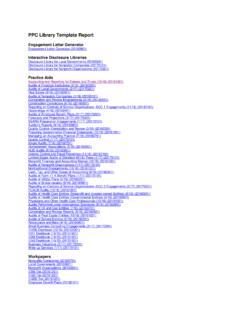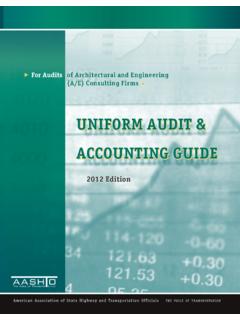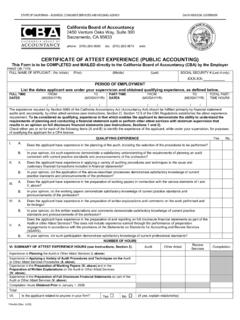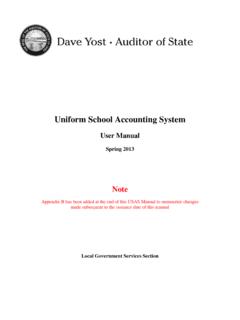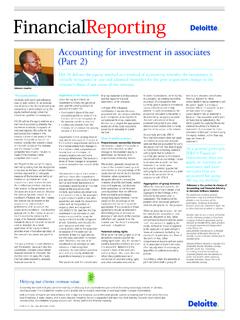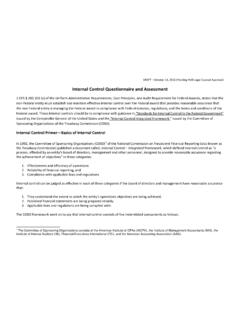Transcription of Glossary of Accounting Terms - El Paso CPA & Tax Firm
1 Glossary of Accounting Terms Account: A record that holds the results of financial transactions. Accountant's Equation: The equation that is the basis of the Balance Sheet: Assets = Liabilities + Owners' Equity. Accounting : A service that oversees, measures, and evaluates financial information for decision making purposes. Accounts Payable: Amounts due from your business to your creditors. Generally these are short term liabilities (30-120 days), and are shown under the Current Liabilities section in the Balance Sheet. Accounts Receivable: Amounts due to your business from your customers.
2 Generally these amounts are short term receivables (30-120 days), and are shown under Current Assets section in the Balance Sheet. Accounts Receivable Turnover: A measure used to determine a company's average collection period for receivables. Usually computed by dividing net sales (or net credit sales) by average accounts receivable. Accrual Basis Accounting : The practice of bookkeeping when income is recorded when earned and expenses are recorded when they are incurred. Aging Schedule: A schedule showing the length of time an invoice has been outstanding or held. Aging schedules are normally created for Accounts Payable and Accounts Receivable.
3 For example, an aging schedule for accounts receivable can show how many days an invoice has been outstanding. Aging schedules can also be created for inventory. Amortization: The gradual and periodic reduction of an amount over time. It can apply to either the periodic write-down of an asset (see depreciation) or a gradual extinguishment of a debt (payments reducing loan principal). Annual Percentage Rate (APR): Also known as effective annual rate, is used to put investments with varying interest compounding periods (daily, monthly, semiannually) on a common basis. It is computed as follows: APR = (1 + r/m) m - where r = the stated, nominal, or quoted rate, and m = the number of compounding periods per year.
4 Annual Report: A report prepared by a business entity at the end of its calendar or fiscal year. It presents a company's financial position and operating results for use by interested parties, including potential investors, creditors, stockholders, and employees. Arm's-Length Transaction: Business dealings between independent and rational parties who are looking out for their own interests. Assets: Economic resources owned or controlled by a person or company. Source: The ABC s of Small Business Audit: The result of an independent accountant's review of the financial statements and their footnotes to ensure compliance with generally accepted Accounting principles (GAAP) and to express an opinion on the fairness of the financial statements.
5 Audit Opinion: The official result of an audit. A CPA's "unqualified opinion" means that the financial statements he/she has audited present fairly the financial position and operating results of the company in conformity with GAAP. A "qualified opinion" occurs under a number of circumstances, for instance, if the financial statements do not follow GAAP and the client refuses to make the needed changes. An "adverse opinion" happens when the financial statements are misleading and do not fairly represent a company's financial position. (Just because you passed an audit, it does not mean that your company is in good financial shape.)
6 It just means that your books are a fair representation of what you did.) Bad Debt: An uncollectible Account Receivable. Balance sheet: A balance sheet is an itemized statement which lists the total assets and the total liabilities of a given business to show its net worth at a given moment in time (like a snapshot). Bank Reconciliation: Verification that your bank statement and your checkbook balance. Bankruptcy: This involves a discharge of the debtor's obligations through court order. The purpose of bankruptcy is to provide the debtor with a fresh start and to have an equitable distribution of the debtor's assets among the creditors.
7 Board of Directors: Individuals elected by the stockholders to govern a corporation. Bond: A contract between a borrower and a lender. The borrower promises to pay a specified rate of interest for each period the bond is outstanding and repay the principal at the maturity date. Bookkeeping: The act of systematically recording the financial transactions affecting a business. Book Value: The net amount (original value plus or minus any adjustments such as depreciation) shown in the accounts for an asset, liability, or owners' equity item. Break-even point: The volume point of sales at which revenues and costs are equal; a combination of sales and costs that will yield a no profit/no loss operation.
8 Budget: A formal statement of management's expectations of sales, expenses, volume, and other financial transactions of an organization. A budget is a tool for planning and control. In the beginning it can act as a plan and in the end it can act as control to measure performance against so that future plans can be improved. Business: An organization created with the objective of making a profit from the sale of goods or services. Business Failure: According to law, business failure can be either "technical insolvency" or "bankruptcy." In technical insolvency a business is unable to meet current obligations even if the total assets exceed total liabilities.
9 In bankruptcy, liabilities exceed the market value of the assets and a negative net worth exists. (See accountant's equation). Calendar Year: An entity's reporting year, covering 12 months and ending on December 31. (See: Fiscal year) Capital: Property or money used and owned by a business and used to acquire future income or benefits. Source: The ABC s of Small Business Capital Account: An account where an owner's or partners' interest in the business is recorded. It is increased by owner investment and net income and decreased by withdrawals and net losses. Capital Gain or Loss: The difference between the market and book value at purchase or other acquisition realized at the sale or disposition of a capital asset.
10 Capital Expense: A capital expenditure is one that will benefit one year or more. It can increase the quantity or quality of services to be gained from the asset. It is charged to an asset account. Capital Lease: Although the lessee does not legally own rental property, the property is theoretically acquired and recorded as an asset with the related liability. Capital Stock: The ownership shares of a corporation authorized by its articles of incorporation, including preferred and common stock. Cash Basis: A bookkeeping method that recognizes revenue and expenses at the time of cash receipt or payment.
